
Hermit crabs are anomuran decapod crustaceans of the superfamily Paguroidea that have adapted to occupy empty scavenged mollusc shells to protect their fragile exoskeletons. There are over 800 species of hermit crab, most of which possess an asymmetric abdomen concealed by a snug-fitting shell. Hermit crabs' non-calcified abdominal exoskeleton makes their exogenous shelter system obligatory. Hermit crabs must occupy shelter produced by other organisms, or risk being defenseless.

The Australian land hermit crab is a terrestrial hermit crab species, native to Australia. It is a nocturnal, omnivorous crustacean. They are gregarious and thrive in tropical areas near water.

Anomura is a group of decapod crustaceans, including hermit crabs and others. Although the names of many anomurans include the word crab, all true crabs are in the sister group to the Anomura, the Brachyura.
Pagurapseudidae is a family of crustaceans in the order Tanaidacea. Like hermit crabs, they inhabit empty gastropod shells, but can be told apart from hermit crabs by the lack of a carapace, revealing the segmentation of the thorax, and by the greater number of legs: hermit crabs have five pairs of legs, of which the first has large claws, and the last is highly reduced, while in Pagurapseudidae, there is one pair of claws, plus six further walking legs.

The halloween hermit crab, also known as the striped hermit crab or orange legged hermit crab, is a brightly colored aquatic hermit crab of the family Diogenidae. Besides its ability to routinely clean algae in aquariums, the halloween hermit crab's festive striped coloration also appeals to enthusiasts; it is considered the most brightly colored hermit crab in normal aquarium use.
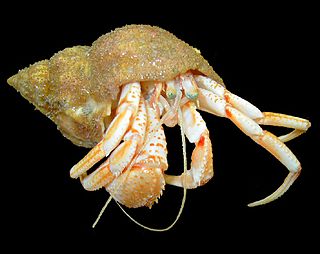
The Paguridae are a family of hermit crabs of the order Decapoda. This family contains 542 species in over 70 genera:

Pagurus novizealandiae, or the New Zealand hermit crab is a hermit crab of the family Paguridae, endemic to New Zealand. Its body is up to 16 millimetres (0.63 in) wide.
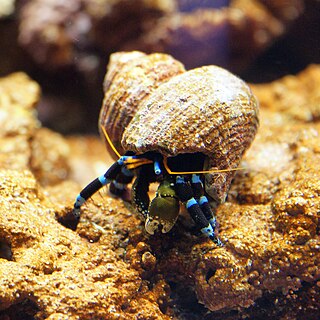
Calcinus elegans, also known as the blue line hermit crab, is a small, tropical hermit crab.

Diogenes pugilator is a species of hermit crab, sometimes called the small hermit crab or south-claw hermit crab. It is found from the coast of Angola to as far north as the North Sea, and eastwards through the Mediterranean Sea, Black Sea and Red Sea. Populations of D. pugilator may be kept in check by the predatory crab Liocarcinus depurator.

Dardanus pedunculatus, the anemone hermit crab, is a species of hermit crab from the Indo-Pacific region. It lives at depths of up to 27 m and collects sea anemones to place on its shell for defence.

Amarinus lacustris is a species of freshwater crab from Australia, New Zealand and nearby islands, where it lives in water of various salinities. It grows up to 10 mm (0.4 in) wide, with an H-shaped groove on its back. It is an omnivore and is eaten by crayfish and fish. It was first discovered in Lake Pupuke, near Auckland, and is the only freshwater crab in New Zealand.

Ciliopagurus is a genus of hermit crabs, of the family Diogenidae, which are sometimes referred to as the "left-handed hermit crabs", because in contrast to most other hermit crabs, the left chela (claw) is enlarged instead of the right. They are found in the Indo-Pacific region and in the eastern Atlantic Ocean.
Ciliopagurus liui is a species of hermit crab native to the Gulf of Tonkin and waters to the south of Japan.
The Pylojacquesidae are a small family of hermit crabs, comprising only two species in two genera. The family was erected in 2001, after two specimens at Museum für Naturkunde at the Humboldt-Universität zu Berlin were recognised as being quite distinct from other described hermit crabs. The family members differ from other hermit crabs in that their mandibles are chitinous and toothed.
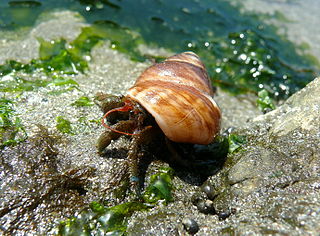
Pagurus samuelis, the blueband hermit crab, is a species of hermit crab from the west coast of North America, and the most common hermit crab in California. It is a small species, with distinctive blue bands on its legs. It prefers to live in the shell of the black turban snail, and is a nocturnal scavenger of algae and carrion.
Calcinus tubularis is a species of hermit crab. It is found in the Mediterranean Sea and around islands in the Atlantic Ocean, where it lives below the intertidal zone. Its carapace, eyestalks and claws are marked with numerous red spots. C. tubularis and its sister species, C. verrilli, are the only hermit crabs known to show sexual dimorphism in shell choice, with males using normal marine gastropod shells, while females use shells of gastropods in the family Vermetidae, which are attached to rocks or other hard substrates.
Porcellanopagurus edwardsi is a species of hermit crab that lives in the waters around New Zealand and its subantarctic islands.
Pagurus forbesii is a species of hermit crab in the family Paguridae. It is found in the northeastern Atlantic Ocean and the Mediterranean Sea.
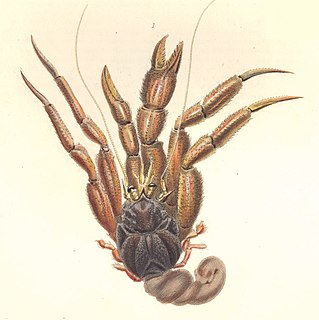
Labidochirus splendescens, commonly known as the splendid hermit crab, is a species of hermit crab found in the northeastern Pacific Ocean off the coast of North America. It is more heavily calcified and inhabits smaller mollusc shells than most hermit crabs.
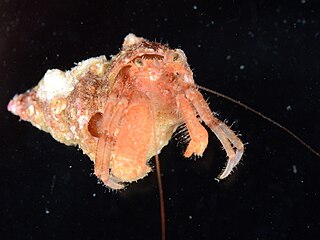
Pagurus dalli, commonly known as the whiteknee hermit, is a species of hermit crab in the family Paguridae. It is found in the northeastern Pacific Ocean at depths down to about 276 m (900 ft). It usually lives in a mutualistic symbiosis with a sponge, or sometimes a hydroid.













